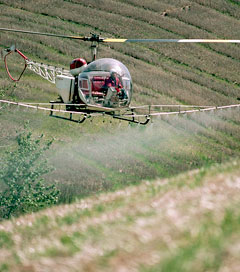
Dow and Monsanto Join Forces to Poison America's Heartland
Richard Schiffman, Truthout | News Analysis
In a match that some would say was made in hell, the nation's two leading producers of agrochemicals have joined forces in a partnership to reintroduce the use of the herbicide 2,4-D, one half of the infamous defoliant Agent Orange [4], which was used by American forces to clear jungle during the Vietnam War. These two biotech giants have developed a weed management program that, if successful, would go a long way toward a predicted doubling of harmful herbicide use in America's corn belt during the next decade [5].
The problem for corn farmers is that "superweeds" have been developing resistance to America's best-selling herbicide Roundup, which is being sprayed on millions of acres in the Midwest and elsewhere. Dow Agrosciences has developed a strain of corn that it says will solve the problem. The new genetically modified variety can tolerate 2,4-D, which will kill off the Roundup-resistant weeds, but leave the corn standing. Farmers who opt into this system will be required to double-dose their fields with a deadly cocktail of Roundup plus 2,4-D, both of which are manufactured by Monsanto.
But this plan has alarmed environmentalists and also many farmers, who are reluctant to reintroduce a chemical whose toxicity has been well established. The use of 2,4-D is banned in several European countries and provinces of Canada. [6] The substance is a suspected carcinogen, which has been shown to double the incidence of birth defects in the children of pesticide applicators in a study conducted by University of Minnesota pathologist Vincent Garry [7].
Researchers say that the effect of 2,4-D on human health is still not fully understood. But it may be a risk factor for conditions like Hodgkin's lymphoma, non-Hodgkin's lymphoma and certain leukemias [8], which were often found in Vietnam veterans exposed to Agent Orange. The Environmental Protection Agency (EPA) has stated that the chemical could have "endocrine disruption potential" [9] and interfere with the human hormonal system. It may prove toxic to honeybees, birds and fish, according to research conducted by the US Forest Service and others. [10] In 2004, a coalition of groups spearheaded by the Natural Resources Defense Council and the Pesticide Action Network, wrote a letter to the EPA taking it to task for underestimating the health and environmental impacts of 2,4-D.
Large-scale industrial farming has grown dependent on ever-increasing applications of agrochemicals. Some have compared this to a drug addict who requires larger and larger fixes to stay high. Herbicide use has increased steadily over time as weeds develop resistance and need to be doused with more and deadlier chemicals to kill them. This, in turn. requires more aggressive genetic engineering of crops that can withstand the escalating chemical assault.
Many agricultural scientists warn that this growing addiction to agrochemicals is unsustainable in the long run. The fertility of the soil decreases as earthworms and vital microorganisms are killed off by pesticides and herbicides. They also pollute the groundwater and compromise the health of farm animals that are fed with the chemical-infused grain.
These impacts are poised to grow. US Department of Agriculture (USDA) figures reveal that herbicide use rose by 383 million pounds from 1996 to 2008 [11]. Significantly, nearly half of this increase (46 percent) took place between 2007 and 2008 as a result of the hawking of new herbicide-resistant crops like the new corn hybrid developed by Dow.
Nobody knows what effect introducing this hybrid would have on the health of American consumers. Corn laced with high levels of 2,4-D could taint everything from breakfast cereals to the beef of cattle, which concentrate the toxin in their flesh. Given that corn and high-fructose corn syrup are key elements in so many processed foods, some public health experts warn that all Americans will soon be guinea pigs in an ill-conceived mass experiment with one of the staples of our food supply. America's agriculture department, the USDA is considering deregulating Monsanto's new genetically modified corn variety (the one which will be used in conjunction with the 2,4-D) and is accepting final public comments on the matter until the 27th of this month [12].
Until recently, herbicide-resistant crops were popular with farmers who benefited from higher yields and nearly effortless management of weeds. But now that the weed problem is coming back with a vengeance, some are reconsidering the wisdom of this chemical-intensive mode of farming. Dow biotech corn costs nearly three times more than conventional seed. And the projected doubling of pesticide use in the years ahead [13] will be expensive, as well as destructive to farmland and ecosystems.
There are viable alternatives to chemical-intensive farming, time-tested methods like crop rotation, use of cover crops, and other practices which allow farmers to compete naturally with weeds. The time has come for farmers to revive the knowledge of their ancestors in this regard.
Some agricultural scientists advocate developing a system of integrated weed management to replace the unsustainable use of chemicals. [13] But the big agrochemical companies have no interest in supporting the sustainable agriculture that would put them out of business. So long as there are billions of dollars to be made in selling herbicide and herbicide-resistant genetically modified seed, there won't be much research money available to explore the natural alternatives to the destruction of our nation's heartland.

